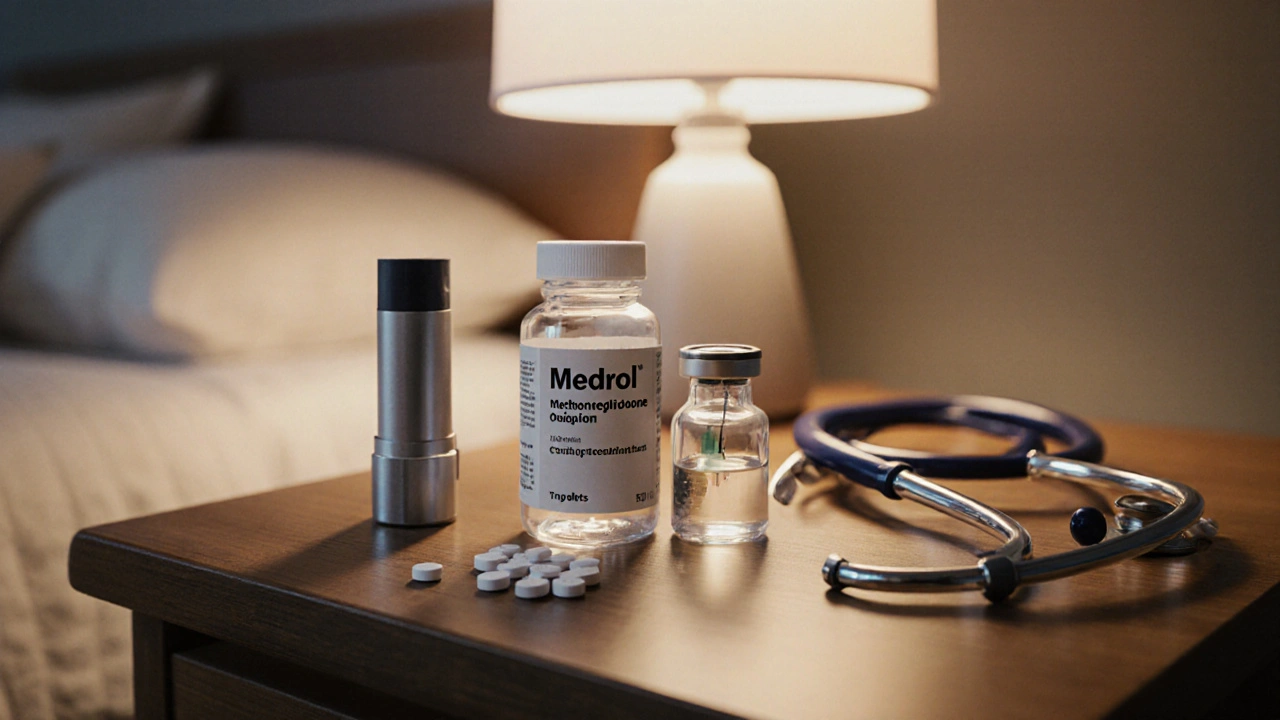Steroid Dose Converter
Convert between different corticosteroids based on their relative potency. Enter your current steroid dose and select which steroid you want to convert to.
Equivalent Dose
Enter your current steroid and dose to see the equivalent dose for your selected steroid.
How This Works
Steroids have different potency levels. For example, 1mg of dexamethasone is equivalent to about 4-5mg of Medrol. This tool uses the average potency ratios from clinical practice to calculate equivalent doses.
Key Takeaways
- Medrol (methylprednisolone) is a mid‑strength oral/injectable glucocorticoid.
- Prednisone is slightly weaker but available in a cheap, tablet form.
- Dexamethasone offers high potency and a longer half‑life, ideal for brain swelling.
- Hydrocortisone mimics the body’s natural cortisol and is gentler on metabolism.
- Choosing the right steroid depends on potency, duration, route, and individual health factors.
What is Medrol?
Medrol is a synthetic glucocorticoid (methylprednisolone acetate) used to treat inflammation, allergic reactions, and autoimmune disorders. It works by suppressing the immune system and reducing the production of inflammatory chemicals.
Doctors prescribe Medrol for conditions such as asthma flare‑ups, rheumatoid arthritis, skin rashes, and certain eye inflammations. The drug comes in tablets and an injectable form, giving flexibility for short‑term bursts or tapering schedules.
Why Compare Medrol with Other Steroids?
If you or someone you care for has been offered Medrol, you might wonder whether a different steroid would be safer, cheaper, or more effective for the specific condition. Steroids differ in strength, how long they stay in the body, and side‑effect profiles. A clear side‑by‑side view helps you discuss options with a clinician and avoid surprises.
Comparison Criteria
We’ll measure each drug on five practical axes that matter to patients:
- Potency - relative anti‑inflammatory strength compared with hydrocortisone (baseline 1×).
- Typical Dose - common adult dose for acute inflammation.
- Half‑Life - how long the drug remains active in the bloodstream.
- Common Uses - the clinical scenarios where the drug shines.
- Notable Side Effects - warnings that frequently influence choice.
Side‑by‑Side Comparison Table
| Drug | Potency (vs Hydrocortisone) | Typical Adult Dose | Half‑Life | Common Uses | Key Side Effects |
|---|---|---|---|---|---|
| Medrol | 4-5× | 4‑16mg oral daily (or 40‑80mg IM) | 18‑36hours | Asthma, arthritis, dermatologic eruptions | Weight gain, mood swings, glucose rise |
| Prednisone | 4× | 5‑60mg oral daily | 12‑36hours | Autoimmune disease, COPD exacerbation | Osteoporosis, insomnia, stomach upset |
| Dexamethasone | 25-30× | 0.75‑9mg oral daily | 36‑72hours | Brain edema, severe allergies, chemotherapy‑induced nausea | Severe glucose spikes, facial flushing |
| Hydrocortisone | 1× (baseline) | 20‑60mg oral daily | 8‑12hours | Adrenal insufficiency, mild inflammatory states | Less weight gain, but requires multiple daily doses |
| Betamethasone | 25× | 0.5‑2mg oral daily | 36‑48hours | Severe skin disorders, obstetric lung maturation | Skin thinning, delayed wound healing |
Deep Dive into Each Alternative
Prednisone is a synthetic glucocorticoid known for its affordability and widespread availability in tablet form. It is roughly equivalent in potency to Medrol, making it a common replacement when injection isn’t needed.
Because prednisone is inexpensive, many insurance plans favor it for chronic conditions like lupus or severe eczema. However, long‑term use can lead to bone density loss, so bone‑protective strategies (vitaminD, calcium) are often recommended.
Dexamethasone is a high‑potency glucocorticoid with a long half‑life, ideal for conditions requiring sustained suppression. Its strength means lower milligram doses achieve the same effect as higher doses of Medrol.
Clinicians love dexamethasone for brain tumors and severe allergic reactions because it crosses the blood‑brain barrier well. The trade‑off is a higher risk of blood‑sugar spikes, so diabetic patients need close monitoring.
Hydrocortisone is a naturally occurring cortisol analog with the weakest anti‑inflammatory action among the listed steroids. It’s often the go‑to for adrenal insufficiency or mild inflammation.
Because its effect wears off in about a dozen hours, patients usually split the daily dose into two or three pills, which can affect adherence.
Betamethasone is a potent synthetic glucocorticoid frequently used in dermatology and obstetrics. Topical forms treat psoriasis, while oral tablets help accelerate fetal lung development when pre‑term birth is imminent.
Its potency means a very low oral dose, but it also carries a higher chance of skin thinning and delayed wound healing, so it’s rarely the first pick for systemic inflammation.

How to Choose the Right Steroid
Think of steroid selection as a balance sheet. Write down the condition you’re treating, the desired speed of relief, and any pre‑existing health issues (diabetes, osteoporosis, infections). Then match those facts against the table’s potency and half‑life columns.
Here’s a quick decision flow:
- If you need a fast, short‑term burst for a severe flare‑up, Medrol or Prednisone are solid choices.
- If the inflammation is in the brain, eye, or near‑central nervous system, lean toward Dexamethasone for its superior penetration.
- If you have a history of high blood‑sugar or severe osteoporosis, consider the milder Hydrocortisone or a very low dose of Prednisone.
- For dermatologic conditions or fetal lung maturation, Betamethasone often wins despite its potency.
Always discuss tapering plans with your doctor-abruptly stopping any steroid can trigger adrenal crisis.
Common Pitfalls and How to Avoid Them
- Assuming higher potency is always better. A stronger drug can cause more severe side effects, especially in long‑term use.
- Ignoring the half‑life. A short half‑life may require multiple daily doses, hurting compliance.
- Skipping bone‑protective measures. Steroids of any potency suppress calcium absorption; supplement if you’re on a course longer than two weeks.
- Not monitoring blood glucose. Diabetes patients often need dose adjustments or additional insulin.
Next Steps and Troubleshooting
If you’ve been prescribed Medrol and are uncertain about alternatives, follow these steps:
- Write down the condition being treated and the planned duration.
- Check the comparison table for a drug that matches the needed potency and half‑life.
- Ask your prescriber about side‑effect monitoring (blood sugar, bone density, mood changes).
- If cost is a concern, request a generic equivalent like prednisone and discuss dose‑adjustment options.
- Set a reminder to review the steroid course after 1‑2 weeks - adjust or taper if symptoms improve.
Remember, steroids are powerful tools, but like any tool, they work best when matched to the right job.
Frequently Asked Questions
Is Medrol stronger than prednisone?
Medrol (methylprednisolone) and prednisone have very similar potency-about four times stronger than hydrocortisone. The choice often hinges on formulation (tablet vs. injectable) and personal tolerance.
Can I switch from Medrol to dexamethasone for a brain injury?
Yes, doctors sometimes swap to dexamethasone because it penetrates the central nervous system better and lasts longer, reducing the number of doses needed.
What are the biggest side effects to watch for with Medrol?
Common concerns include increased appetite and weight gain, mood swings or insomnia, elevated blood glucose, and, with prolonged use, bone loss.
Is it safe to use over‑the‑counter hydrocortisone cream while on oral steroids?
Topical hydrocortisone in low strengths (1% or less) is generally safe, but high‑potency ointments can add to systemic exposure, especially on large skin areas.
How long should I stay on Medrol before tapering?
Short courses (under 2 weeks) often don’t need tapering. Anything longer usually requires a gradual reduction over several days to weeks, under medical guidance.

Hoyt Dawes
October 12, 2025 AT 15:35Medrol? It's just another glorified painkiller for the masses.
Jeff Ceo
October 17, 2025 AT 06:50While you dismiss Medrol outright, the reality is that its pharmacokinetics make it a reliable option for many patients, and dismissing it without nuance is irresponsible.
Jean-Sébastien Dufresne
October 21, 2025 AT 22:30Wow!!! This tool is *amazingly* useful!!! 🤓 How many of us actually understand the conversion factors? It’s like trying to translate Shakespeare into emoji!!! 😂🤯
Patrick Nguyen
October 26, 2025 AT 13:53Indeed, the conversion ratios are clinically validated.
Patrick Bread
October 31, 2025 AT 05:16Oh great, because we all needed another spreadsheet of steroid math.
Fiona Doherty
November 4, 2025 AT 20:40Honestly, anyone still using Medrol over newer formulations is stuck in the past.
Neil Greer
November 9, 2025 AT 12:03yeah, but some docs still swear by it for acute flare‑ups, lol.
Fionnuala O'Connor
November 14, 2025 AT 03:26Remember, matching potency is key for safe tapering.
Christopher MORRISSEY
November 18, 2025 AT 18:50When one considers the breadth of glucocorticoid therapy, the nuances of potency become paramount.
Medrol, or methylprednisolone, occupies a middle ground between low‑potency hydrocortisone and high‑potency dexamethasone.
Clinicians often select it for its reliable anti‑inflammatory action without the extreme glucocorticoid surge associated with dexamethasone.
However, dose conversion is far from trivial; a naïve substitution can lead to under‑suppression of the immune response.
The conversion calculator provided here simplifies these calculations, yet it is essential to appreciate the underlying pharmacodynamics.
Hydrocortisone, for example, is roughly equivalent to 1 mg of itself, while dexamethasone outpaces it by a factor of roughly 25‑30.
Thus, 4 mg of Medrol roughly mirrors 5 mg of prednisone, a relationship borne out in numerous clinical protocols.
These equivalences guide tapering schedules, especially in chronic autoimmune conditions where abrupt withdrawal precipitates adrenal crisis.
Yet one must not overlook individual patient variability, hepatic metabolism differences, and concomitant medications that may inhibit or induce steroid clearance.
When employing this tool, cross‑check with the latest endocrinology guidelines to ensure safety.
Furthermore, real‑world experience often reveals that patients respond differently to oral versus intravenous routes, affecting bioavailability.
In practice, many physicians maintain a safety margin, prescribing a slightly lower equivalent dose to mitigate side‑effects.
Side‑effects such as hyperglycemia, mood swings, and osteoporosis are dose‑dependent, reinforcing the need for accurate conversion.
Education for patients about these risks enhances adherence and encourages prompt reporting of adverse events.
Ultimately, while this calculator is a valuable aid, it does not replace clinical judgment nor individualized patient assessment.
Continual monitoring and dose adjustments based on therapeutic response remain the cornerstone of responsible glucocorticoid management.
Adam O'Rourke
November 23, 2025 AT 10:13Sure, because swapping mg on a calculator is the pinnacle of medical sophistication 😂.
Mary-Pat Quilty
November 28, 2025 AT 01:36O! The humble Medrol, a silent hero in the storm of inflammation, weathered by countless souls in whispered agony.
Patrick McGonigle
December 2, 2025 AT 17:00For quick reference: 4 mg of Medrol ≈ 5 mg of prednisone; always verify with your prescriber before adjustments.
Keisha Moss Buynitzky
December 7, 2025 AT 08:23I understand the challenges patients face when navigating steroid equivalencies; please know you are not alone in this journey.
Shivam yadav
December 11, 2025 AT 23:46Let’s all share our dosage experiences so newcomers can learn safely and confidently.